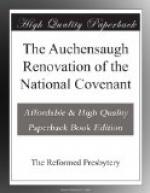Third.—At the time when defection
was progressing in the R.P. Synod of Scotland,
the sister Synod of Ireland strenuously resisted an
attempt to remove the foresaid Bond from its place
in the Terms. The Rev. Messrs. Dick, Smith and
Houston in 1837, were faithful and successful for
the time in resisting that attempt. Mr. Houston
“
would ever resist any alteration in
respect of the Auchensaugh Bond, regarding the objection
laid against it as in reality aimed at the Covenants
themselves.” Yet as a sequel to their Renovation
of the Covenants at Dervock 1853, the Auchensaugh
Bond was subsequently “shown to the porch”—removed
from the Terms!
Fourth.—At what was
called covenant-renovation at Pittsburgh 1871, we
believe no one spoke in behalf of their fathers’
noble achievement in 1712. Indeed this could
not be rationally expected in a body who could tolerate
members vilifying the very Covenants which they pretended
to renew.
Fifth.—Other parties farther
removed from the position of their reforming progenitors;
but who still claim ecclesiastical affinity with John
Knox, and commonly prefix to the symbols of their faith
the historical word
Westminster, give very
strong expression to their feelings of hostility—not
to the Auchensaugh Bond, of which probably they never
heard, but to the British Covenants expressly; yea,
to the very ordinance of public social covenanting
itself. But we shall let them speak for themselves.
One Doctor of divinity is reported as saying—“I
am opposed to the whole matter of covenanting.
Covenants do an immense sight more harm than good.
Those Scotch Covenanters brought persecution upon
themselves by their covenants."[1]
Another Dr. said, “I have always been opposed
to covenanting. One generation of God’s
people have no right to enter into bonds that entail
obligations upon future generations."[2] A third Dr.
said, “I hold it is a sin for men to go into
the august presence of God and enter into covenant
with him. It is base presumption."[3] A fourth
Dr. said, “I hold that the church as an organization
is not a responsible moral agent. Neither is
the nation!” These sentiments may well excite
astonishment and alarm, when proclaimed by accredited
teachers of morality and religion. Sixth.—Seceders
have all along their history claimed to be the sole
heirs of the Scottish covenanted inheritance.
They are not ignorant of the Auchensaugh Renovation.
How they view that transaction may be best ascertained
from their own language. The Original Secession
Magazine for November 1880, p. 861, speaks thus,
“The distinction drawn between ‘Covenanters’
and ‘Seceders,’ we have shown to be groundless.
Are Reformed Presbyterians covenanters at all?
There is not an actual Covenanter among them.
They renewed the Covenants after a fashion in 1712.
In our view the Covenants were not renewed, they were
only mangled,” &c. These sentiments are
sufficiently strong and explicit to be intelligible.




